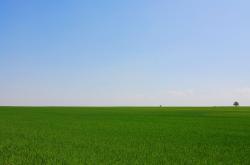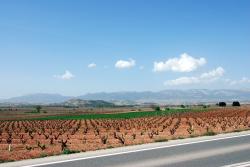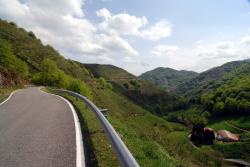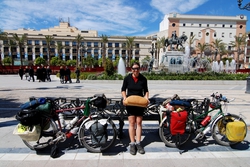 |
Capital: Madrid Currency: Euro Population: 40.4 million Food: Tapas, ham Drink: Wines, sherry |
Spain has some great off-the-beaten-track cycling waiting to be discovered.
You’ll find yourself in beautiful little towns, munching on tapas and drinking with the locals in the village bar.
 On the other hand, beware the over developed eastern and southern coastline, where holiday resorts and busy roads dominate the scenery. There are some small gems among the highrises but they’re few and far between.
On the other hand, beware the over developed eastern and southern coastline, where holiday resorts and busy roads dominate the scenery. There are some small gems among the highrises but they’re few and far between.
Our trip took us through Spain three times during winter and spring 2006/2007. The first time our route followed the Mediterranean coast from the French border, south via Barcelona, Valencia, Alicante and Malaga, from where we took the ferry to Morocco. We returned to Spain again with a ferry to Tarifa and spent a few days along the coast, taking in the Sherry-making towns of Jerez and Sanlucar, turning north to Seville and then crossing into Portugal. Our third and last entry into Spain was from northern Portugal and we crossed through the areas of Rioja, Navarra and the Basque country as we made our way towards France.
 SPANISH HIGHLIGHTS
SPANISH HIGHLIGHTS
The highlights for us were the Sherry-region of Spain, particularly the towns of Medina Sidiona, Jerez and Sanlucar de Barameda. The Delta d’Ebre rice fields along the Mediterranean coast were one of the few nice breaks from the sprawl, memorable as well for their unique landscape and varied bird life. Not far from Malaga, the Alpujarra mountains offered beautiful if challenging cycling. During our last few days in Spain we followed parts of the Santiago pilgrim trail and were amazed at the wealth of cultural sights in this area: churches, monasteries, Roman ruins and no end of picturesque towns, not to mention the wine!
Afternoon lunches on the beach were another frequent pleasure. You’ll find lots of beaches to eat your lunches on. Soak up the sun and while you’re eating and then use the water taps (normally for washing your feet) to do your dishes!
Although we generally loathed the cities because they were so hard to get in to, once you’re there Valencia is great with lots to offer including an amazing food market, a cathedral, roman ruins, a lovely park and beaches. A really nice stop to rest your legs for a few days. Malaga surprised us as we expected the city to be overrun with expats but it is actually has quite a lot to see including a Picasso museum, cathedral and fortress.
 A MIXED BAG
A MIXED BAG
Spanish roads vary in condition. Some of the back roads are bumpy after being patched over several times. Our bigger concern was finding a quiet alternative to busy routes and in cities like Barcelona it seemed almost impossible to leave without running into endless motorways. Unless you are determined to cycle every mile, it’s worth taking a train or bus into the bigger cities.
We used a Michelin road atlas of Spain and Portugal at 1:400 000 scale and found it adequate in most cases, although sometimes it would have been nice to have a more detailed map to find back road alternatives to the busy highways. Certain roads seem to have recently been renumbered in some of the provinces.
PRICEY CAMPING
We camped as much as possible in Spain but often you pay a lot for not very much in the campgrounds. They are ranked from 1st class (the most expensive) to 3rd class. If you see a sign that says 1st class you can expect to pay the better part of €20 for a tent and two people. This falls dramatically as you go down the ranks. If you go a bit inland, however, and away from the main tourist drag it is easy to wild camp.
 Accommodation costs took their toll on our budget. We tried to live within €25 a day and this was a challenge, although possible if you wild camp a bit and limit beers and other treats. The supermarket chain Dia is a good place for budget shopping and they sell museli at just over €1 for a kilo, great for breakfast! You can expect to pay €50-60 for a two-star hotel, around €1 for a coffee and €7-10 for a set menu in a simple restaurant.
Accommodation costs took their toll on our budget. We tried to live within €25 a day and this was a challenge, although possible if you wild camp a bit and limit beers and other treats. The supermarket chain Dia is a good place for budget shopping and they sell museli at just over €1 for a kilo, great for breakfast! You can expect to pay €50-60 for a two-star hotel, around €1 for a coffee and €7-10 for a set menu in a simple restaurant.
